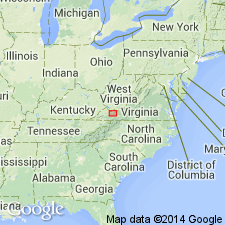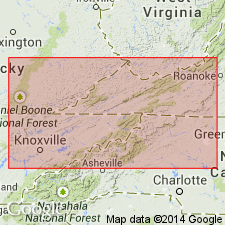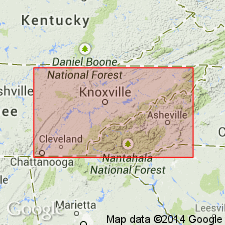
- Usage in publication:
-
- Bowen formation
- Modifications:
-
- Named
- Dominant lithology:
-
- Sandstone
- Mudstone
- AAPG geologic province:
-
- Appalachian basin
Summary:
Named the Bowen formation for Bowen Cove at northwest base of Short Mountain, Tazewell Co., VA. Lower part of formation is brown weathering calcareous sandstone and upper part is red mudrock tongue; these are 14 and 60 feet thick, respectively. The sandstone pinches out 8 miles northeast of Russell-Tazewell Co. line; beyond this point and northeastward to Burkes Garden, Marys Chapel, and Five Oaks, the Bowen is represented only by a tongue of red mudrock. Where both zones of the Bowen occur, there is evidence of disconformity between sandstones of Bowen and underlying buff shales of the Wardell formation; in middle part of Tazewell Co., the hiatus between the buff shales and overlying red mudrock is indicated by absence of zone of brown mudstone; east of meridian of Tazewell, the hiatus includes part of red mudrock which pinches out entirely a few miles northeast; contact with overlying limestones of Witten limestone are conformable. The Bowen is of Middle Ordovician age.
Source: GNU records (USGS DDS-6; Reston GNULEX).

- Usage in publication:
-
- Bowen formation
- Modifications:
-
- Areal extent
- AAPG geologic province:
-
- Appalachian basin
Summary:
Pg. 1171-1172. Bowen formation. Southwest from Tazewell, Virginia, the Bowen is traced in both Copper Creek and St. Paul belts into Tennessee. Sandstone, ordinarily less than 15 feet thick in Virginia, thickens gradually into Tennessee. Mudrock phase varies from about 40 to 100 feet in thickness, locally attains thickness of about 175 feet at Thorn Hill. At Heiskell, Tennessee, both sandstone and claystone phases are present between underlying Wardell formation and overlying Witten limestone. In Knoxville belt, allochthonous to Saltville thrust, the Bowen is present in several places between Knoxville and Lenoir City, and thickness may be as much as 200 feet in places. The sandstone occurs at top of the Sevier and is separated from maroon claystone of the Moccasin formation by a few feet of limestone probably of Witten age. [Age is Middle Ordovician.]
Source: US geologic names lexicon (USGS Bull. 1200, p. 441-442).

- Usage in publication:
-
- Bowen Formation
- Modifications:
-
- Revised
- AAPG geologic province:
-
- Appalachian basin
Summary:
Revised the Bowen Formation to be included in the Chickamauga Group in TN. Consists of quartz siltstone, sandstone, and claystone. Thickness averages 10 meters in study area, but thickens to south and east. Unit overlies the Wardell Formation and underlies the Witten Formation, both of the Chickamauga Group. The Bowen is of Middle Ordovician age.
Source: GNU records (USGS DDS-6; Reston GNULEX).
For more information, please contact Nancy Stamm, Geologic Names Committee Secretary.
Asterisk (*) indicates published by U.S. Geological Survey authors.
"No current usage" (†) implies that a name has been abandoned or has fallen into disuse. Former usage and, if known, replacement name given in parentheses ( ).
Slash (/) indicates name conflicts with nomenclatural guidelines (CSN, 1933; ACSN, 1961, 1970; NACSN, 1983, 2005, 2021). May be explained within brackets ([ ]).

